Hiroshima was still asleep when we left the hotel early in the morning on our way to Nagasaki. It was interesting seeing such a big and busy city empty. Besides two of us dragging our luggage behind our back we saw only two ladies returning home from last night’s parties. They seemed a bit under the influence of alcohol, tired and happy at the same time.
We managed to catch our 6.00 AM Shinkasen that brought us to Shin-Tosu. Shin-Tosu is the last Shinkasen stop on the way to Nagasaki. Shinkasen continues towards the south all the way to Kagoshima, but the peninsula where Nagasaki is situated is not yet connected with the fast trains.
We took that slow train to Nagasaki, riding just 180km/h. 🙂 We arrived a couple of minutes before 11 AM, and we tried to find lockers to leave our luggage here, but that station was in some reconstruction and we had to drag our luggage with us. We were actually rushing to catch the first possible tram towards The Peace Park where the A-bomb memorial was taking place.
Totally unplanned, we exited from Matsuyamamachi station and crossed the road towards Peace Park exactly 70 years after the atomic blast.
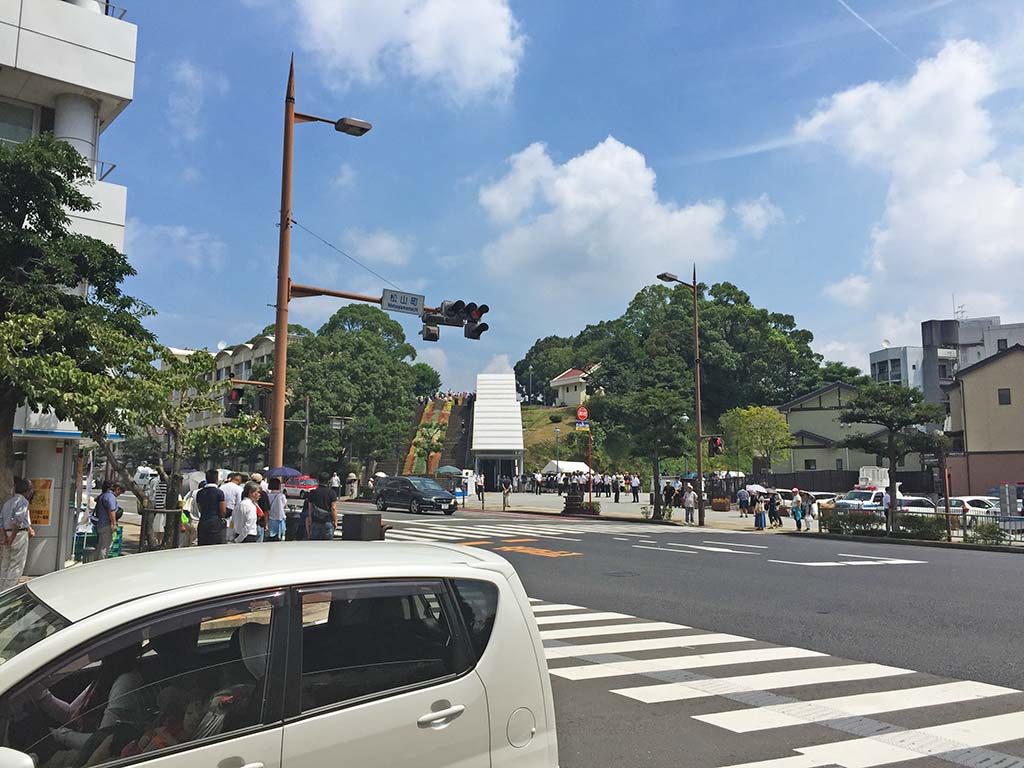
11:02AM. Alarming sirens reminding everyone of the horrible act that left the city in ruins with around 40 000 immediate deaths. The whole city stopped for the moment of silence, traffic stopped, cars turned off in the middle of the street, people standing silently. No one crossing the road, no one walking, no one talking. When the sirens stopped alarming, scary silence lasted for a short moment to pay tribute to all those lost lives, and then everything slowly continued where it stopped just a minute ago.
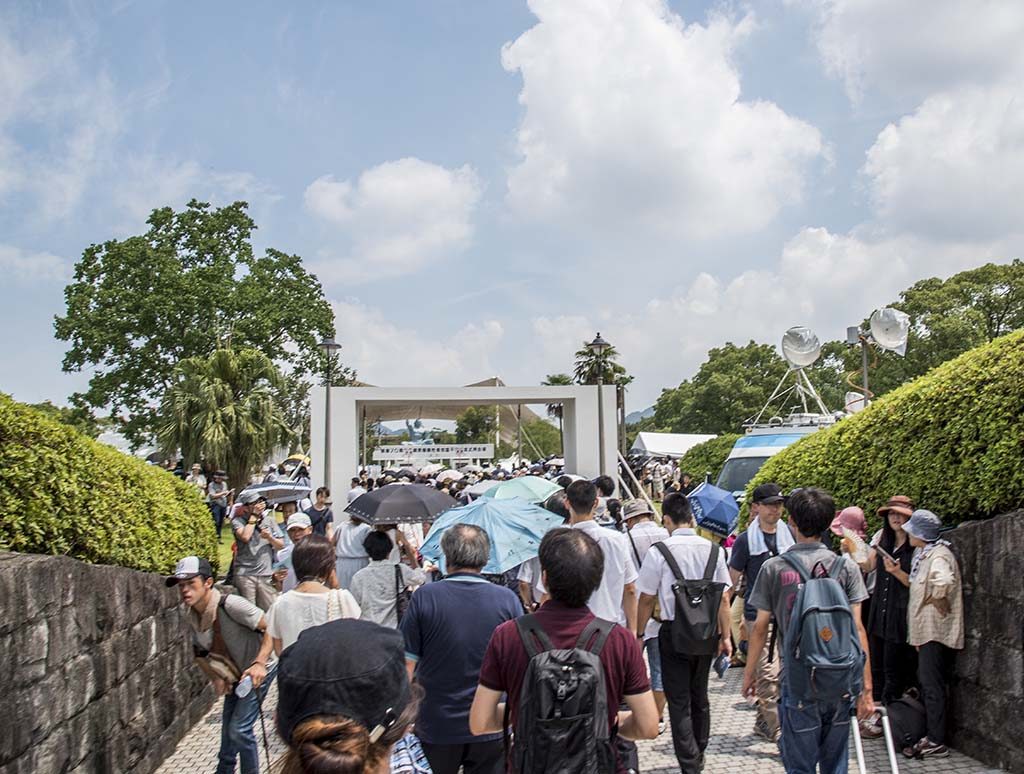
We tried to get closer to the Peace Statue that is located on the top of the hill just a short distance from the place where explosion took place 70 years ago, but that was the centre of the ceremony and was not possible at the time.
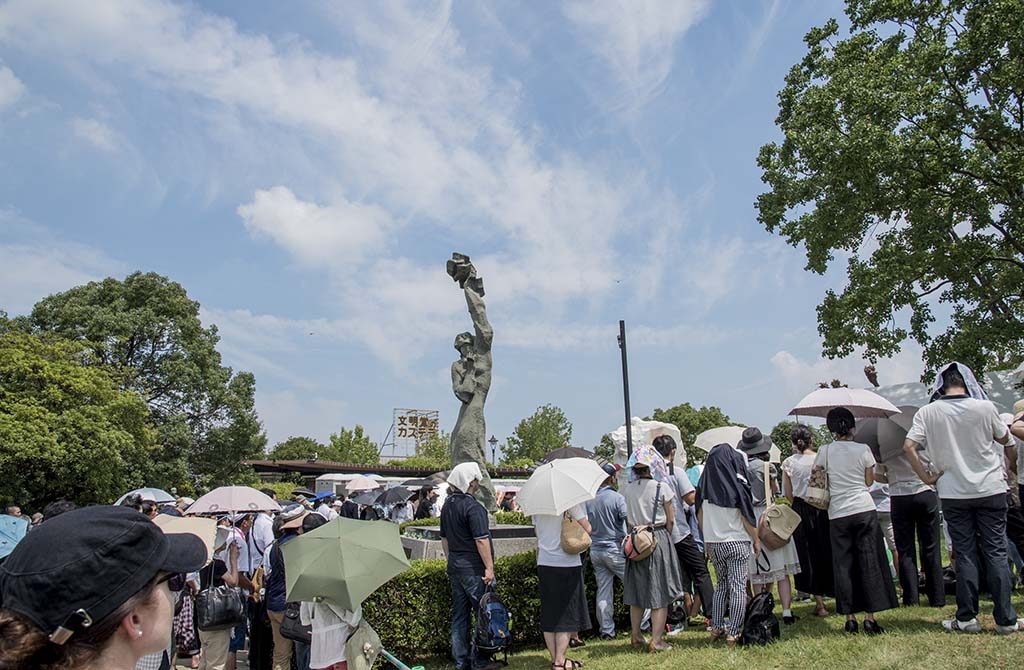
We strolled around the Peace Park for a while, where we passed many statues that can be seen here.

Many of those statues are gifts from many around the world, expressing honest regret because of the bombing, and calling for the world peace.
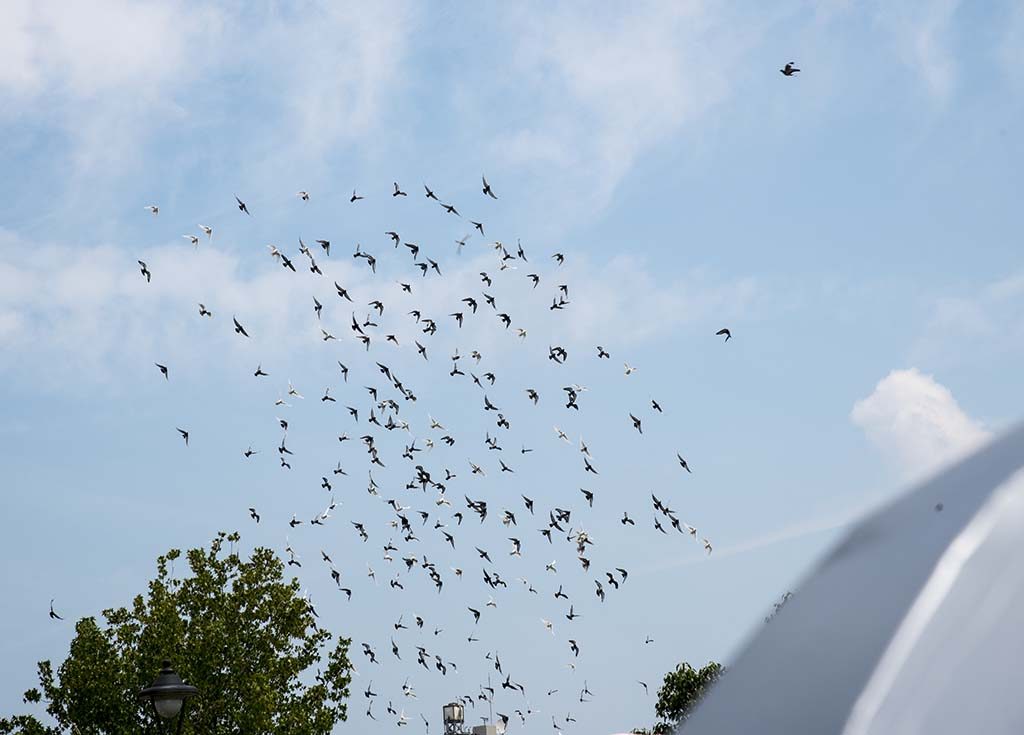
Many (if not 70) birds were released for the peace and for the world in which Atomic bombs will never again be used.
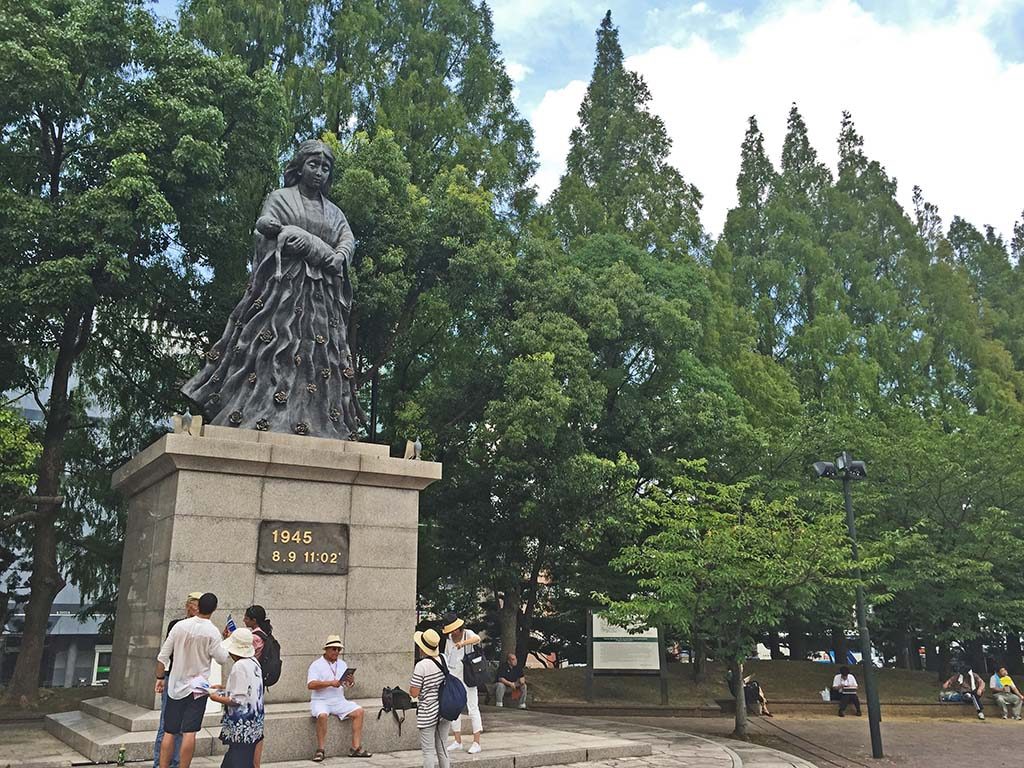
We than descended the hill where the official ceremony took place, into the valley where the blast really happened, Hypocenter Cenotaph. A statue of mother with an infant and exact time of the blast – 11:02 – are there as a reminder and warning for the future.

The only piece that remained standing here after the blast was this column, part of the old Urakami Cathedral, which was the first Catholic Cathedral in Asia.
From the cenotaph we walked along the canals that end up in the Urakami river. The banks were decorated with paintings from various schools remembering this horrible day.
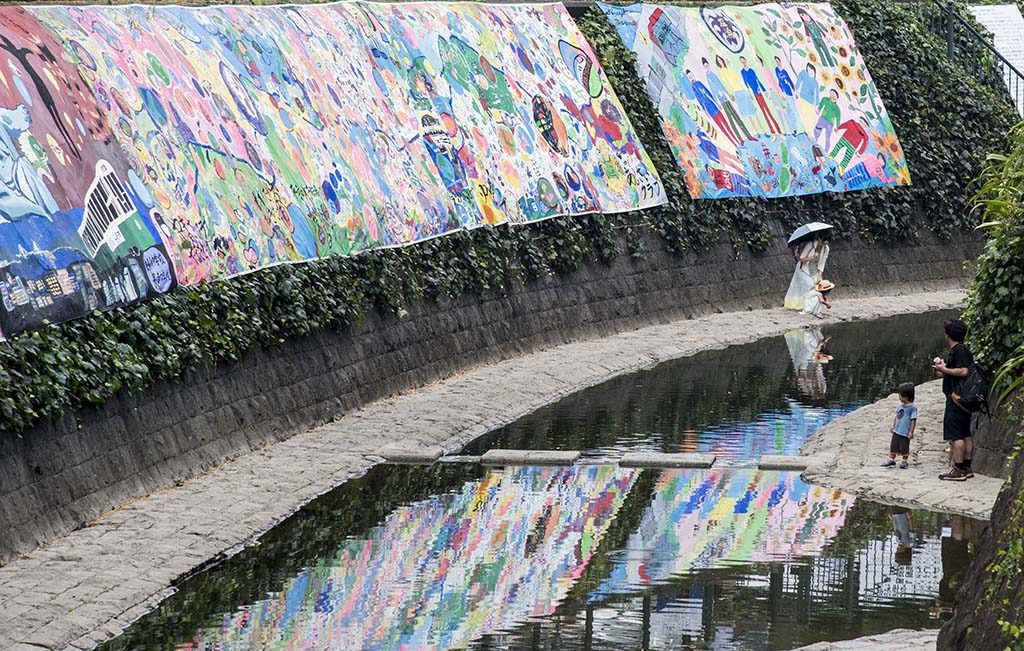
But, even though it was all very decent and respectful towards those who died here, there were musicians from Africa performing tribal drum and base music, a lot of people walking around with their kids, a lot of messages of peace and love everywhere.
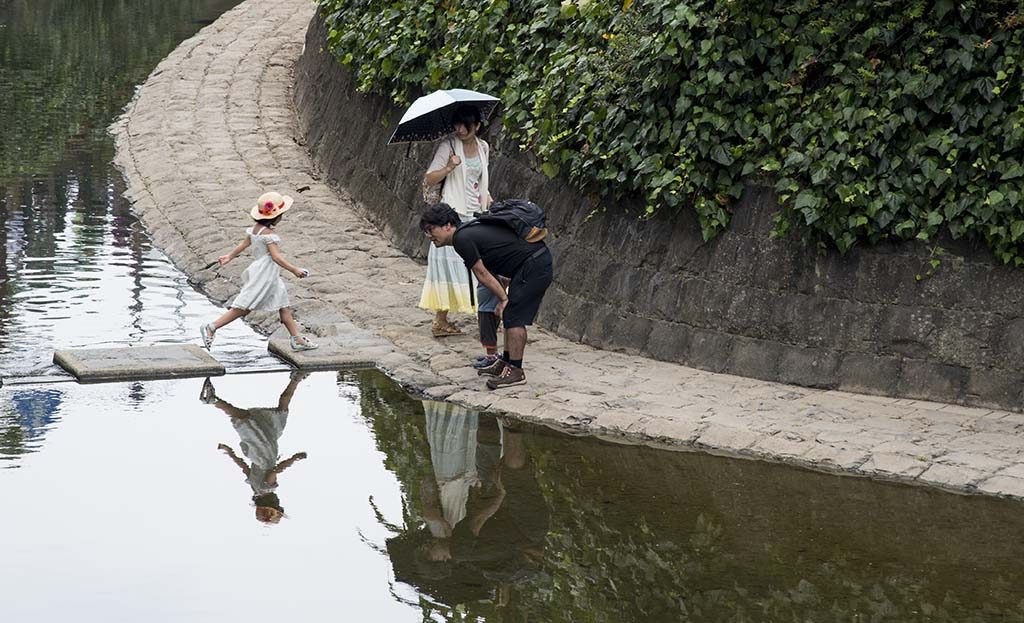
Weather was still not on our side, and temperatures around 38 degrees Celsius forced us to relativity quickly find a place to hide and cool down. Museum was opened and free of charge and so we decided to see this one too, similarly as we did in Hiroshima just yesterday.
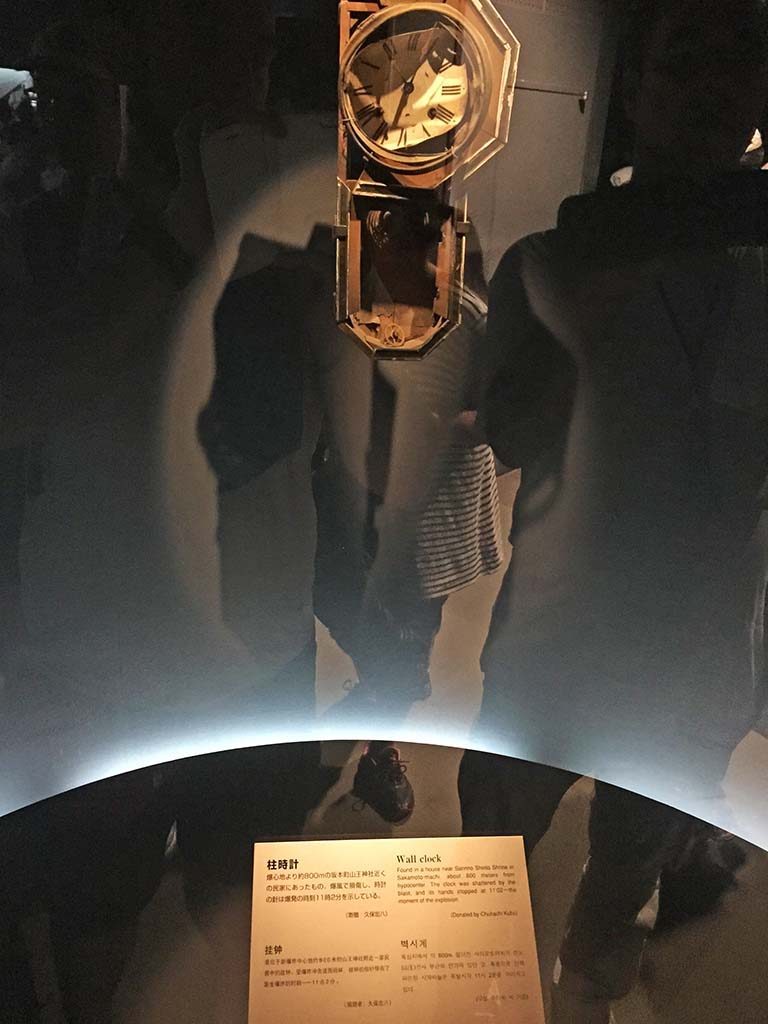
Same feelings of sadness, disbelief, and weakness as in Hiroshima were brought forth once again.
Once we’ve seen the whole Peace Museum, and cooled down we decided to head back to the city centre, leave our luggage in temporary storage, eat and relax a bit. We ended up in the huge Plaza in the city centre during lunch time. It was quite hard to get an empty spot, but in the end we managed to get a decent lunch. Well, it was one of those where we had no idea what we ordered, but it was good. 🙂
Nagasaki is a relatively small city. When I say relatively – if you compare it with other Japanese cities. It just recently got the status of the “core city” (in 1997 according to Wikipedia), as it’s population crossed 400k. Since it was completely ruined just 70 years back, there are not so many well known buildings to visit, so you can see the most of it in a day or two.
Since we only had 2 days to spend here, we decided to – yet again – walk all day long, and then do nothing tomorrow. So we headed to the far south of the city, visiting Oura Cathedral and Glover Garden. By the time we got around that area, Cathedral was closed so we spent the rest of the afternoon in the garden.
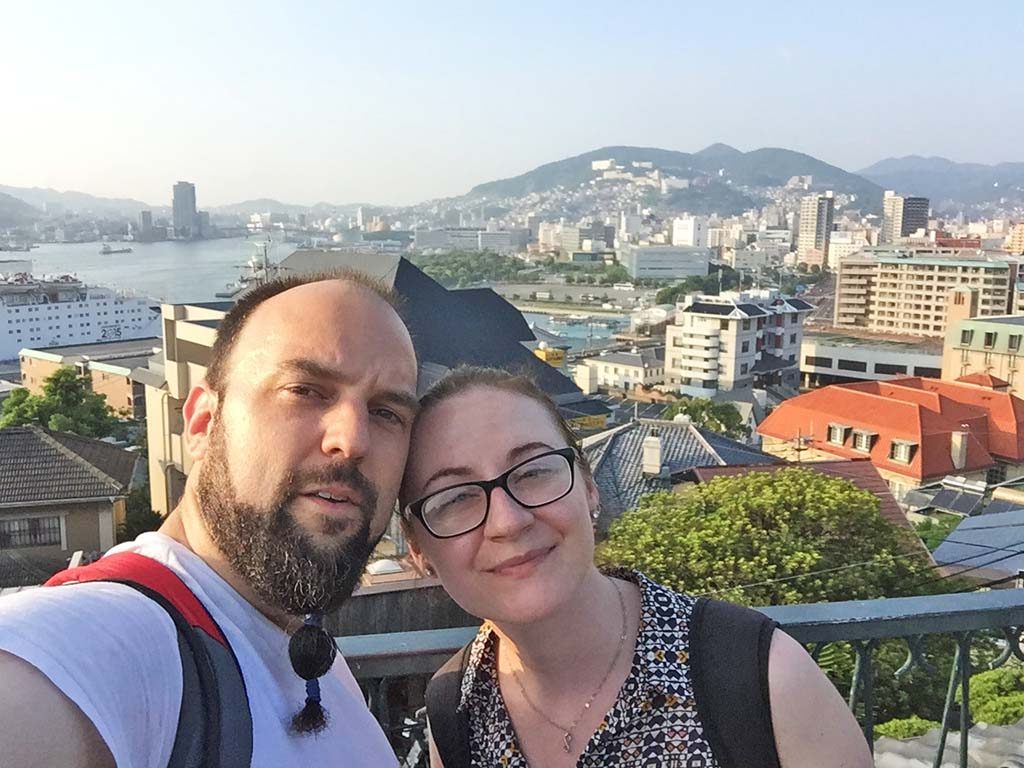
It’s situated on the top of the hill, and from it one can enjoy the overview of Nagasaki bay. Luckily, to get to the top of the hill Japanese built an elevator as we were about to give up on any further sightseeing. 🙂 The view was magnificent, and that platform with elevators has several stops and a 360 path around it, so you can really see almost every corner of the City.
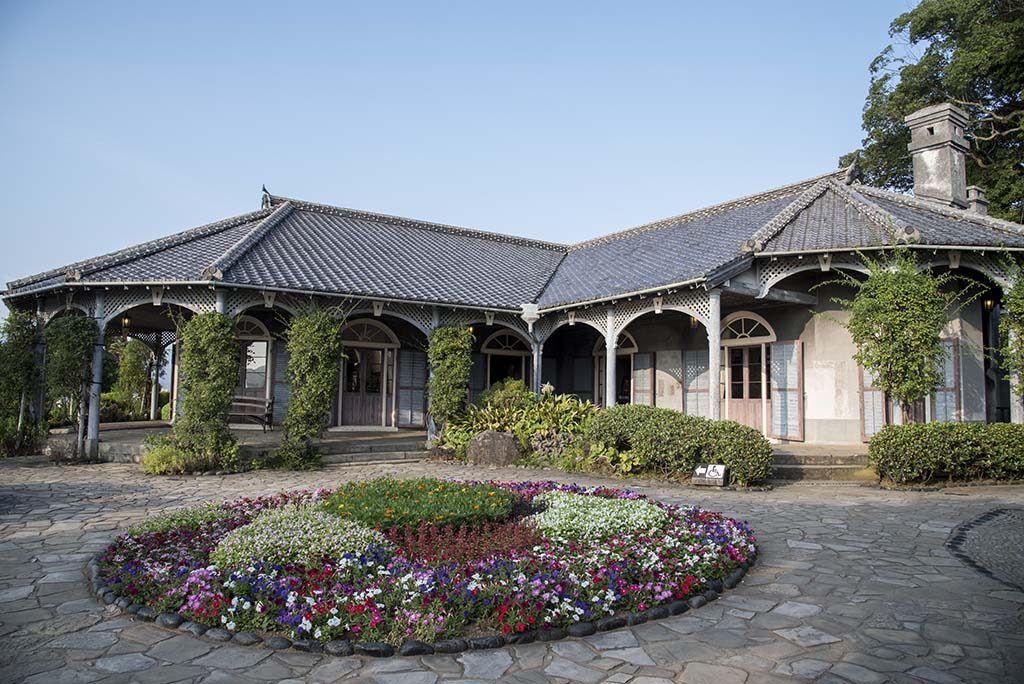
We didn’t really know what to expect from the garden, but it’s a really gorgeous place. Built by the Scotish guy, Glover, a popular tourist attraction and the only Western style house that survived in Japan.

Glover Garden is a blend of Western and Japanese culture, spread across several slopes with a small stream, a pond, fishes, flowers, and several different buildings. On one of the terraces there is an improvised bar where you can get a needed and deserved refreshment.
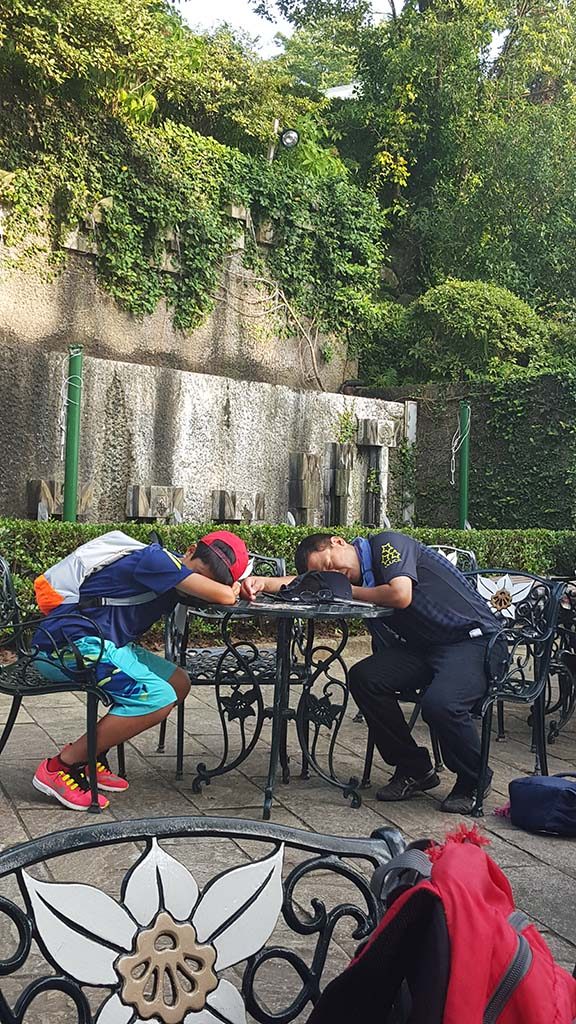
You can take a nap as well. We noticed that it’s absolutely normal in Japan to sleep / nap anywhere in public. People often take a nap in a fancy restaurant after they finished their meal. So did these tired father and son. 🙂
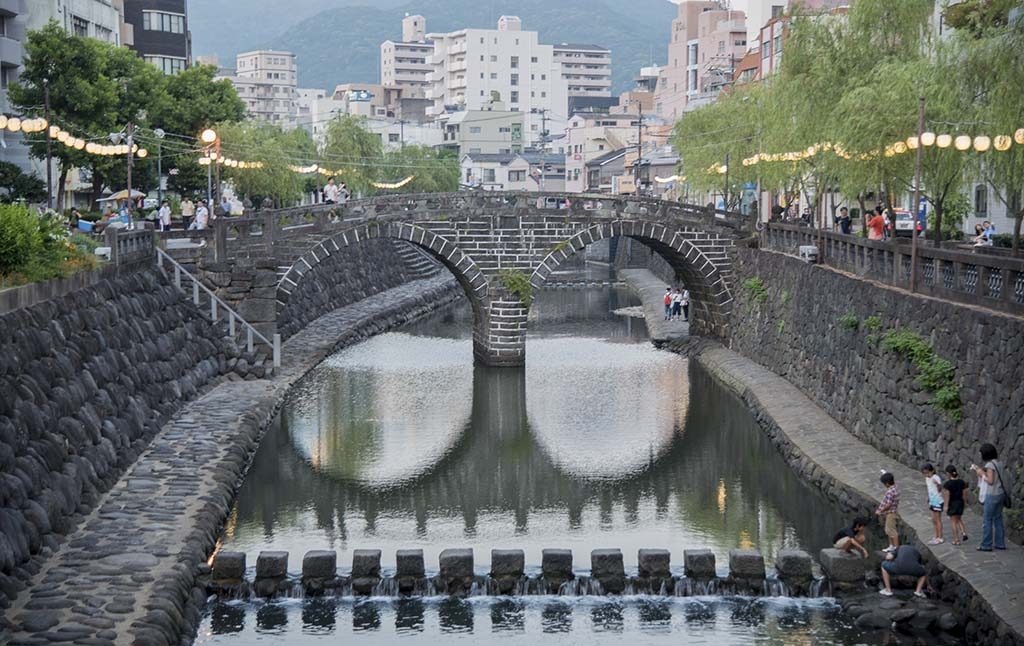
On the way home we passed once again by Oura church, then grabbed a tram towards one of the most iconic bridges in Nagasaki – Megane Bridge. First I read it “Megane” as French car, and was extremely curious what I will see. I learned just later, when we returned to Dublin that Japanese “Megane” means “glasses”. 🙂 It kinda make sense, right?
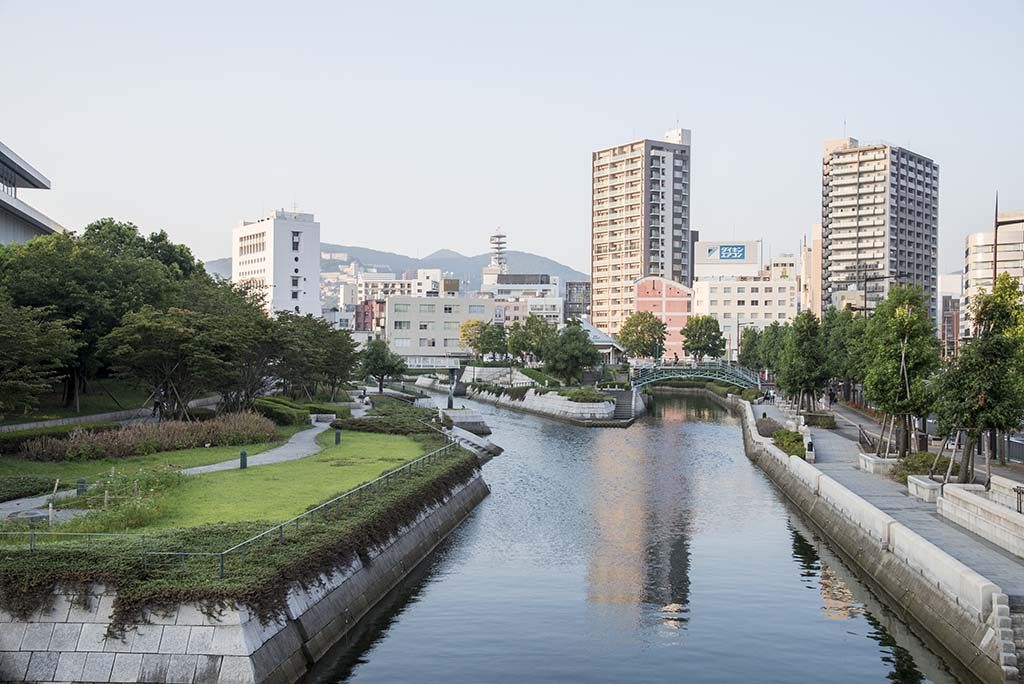
From there we took a walk along the modern Nagasaki coastline through Dejima, all the way back to Plaza where our luggage was. We sat down to eat and wait for our hosts. We ordered some “interesting balls” named Takoyaki. “Tako” in Japanese means octopus, but yet again, we learned that trying it. It’s actually pretty delicious.
Then our local host Majda, who is actually from the same region in Croatia where I’m from (Istria), and her boyfriend Daniel (Texas-Nagasakian guy, the best combination ever) picked us up, and we headed towards their apartment to crash and finally relax a bit.
Instead of relaxing, we had a short house party with the craziest possible crew. Aljoša (2.10m – give or take) tall Croatian guy, Danijel, Majda, her crazy Irish room-mate Carl from Dublin who is the craziest person I’ve met in a last 10 years (positive craziness, full of energy and a good craic) and a couple of locals and their friend from south America. A couple of beers and standard travelo-expat conversations kept us awake for a while.
We made a plan for tomorrow – Shopping early in the morning as I urgently needed a backpack replacement, and then a relaxing day on the beach because Dina insisted so 🙂
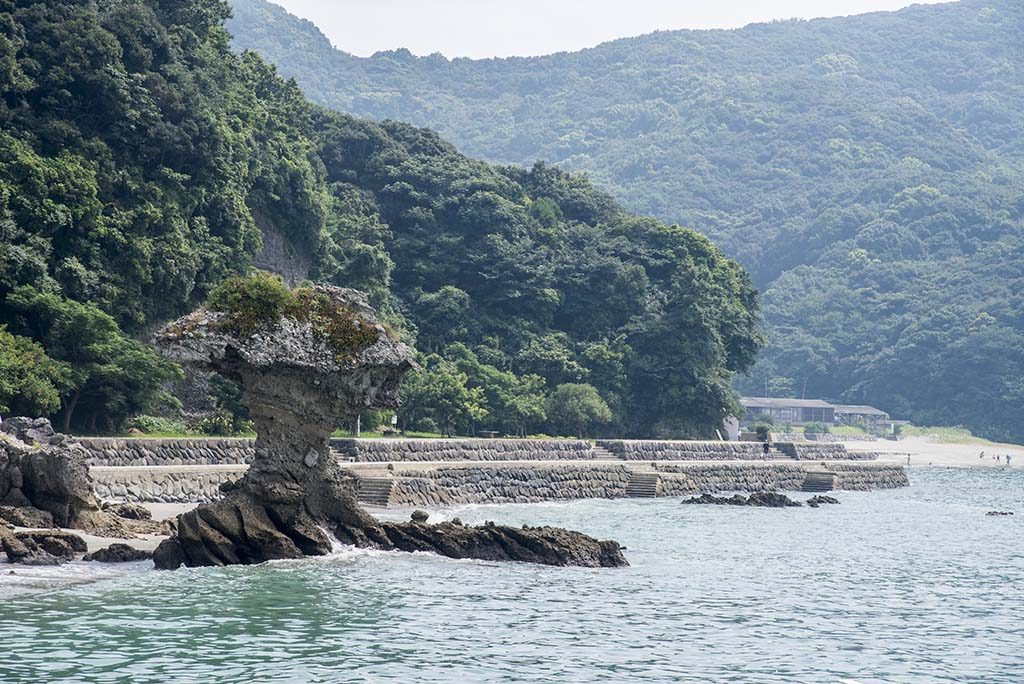
We took the bus that drove us all around the Nagasaki Bay and outside to a totally random and empty beach. Even though it’s 39 degrees Celsius, and the sea is around 27-29 Celsius it seems that swimming – using beaches in Japan is only for teenagers. We were told that it’s a really rear occasion when beaches in Japan are busy, and that those are “open for public” only for a short few weeks in the summer, even though sea and air temperatures are fine till November.
Internet actually says that average sea temperature in Nagasaki during the cold winter times is still around 20 degree Celsius, which means that it would be too warm for me even in the winter. 😀
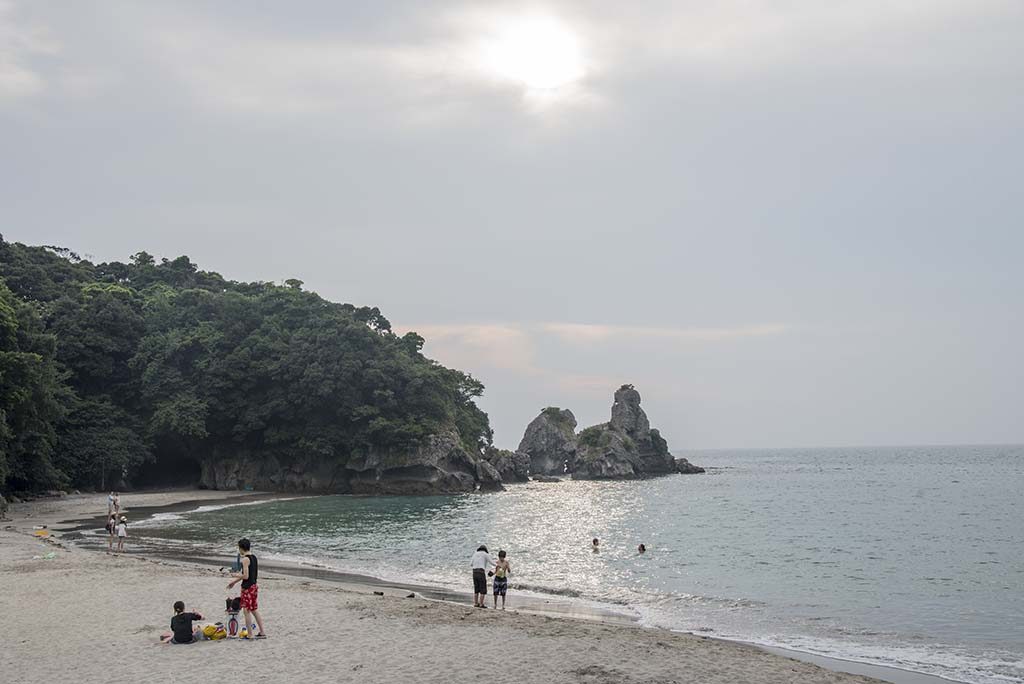
From the beach we went home and prepared ourselves for a totally different dinner, available only in Nagasaki, and then headed towards the best place ever. Crazy Horse bar!

It’s a small bar in the centre of Nagasaki, whose owner takes a photo of every guest, prints it immediately and ask you to sign it, and pins it on the wall.
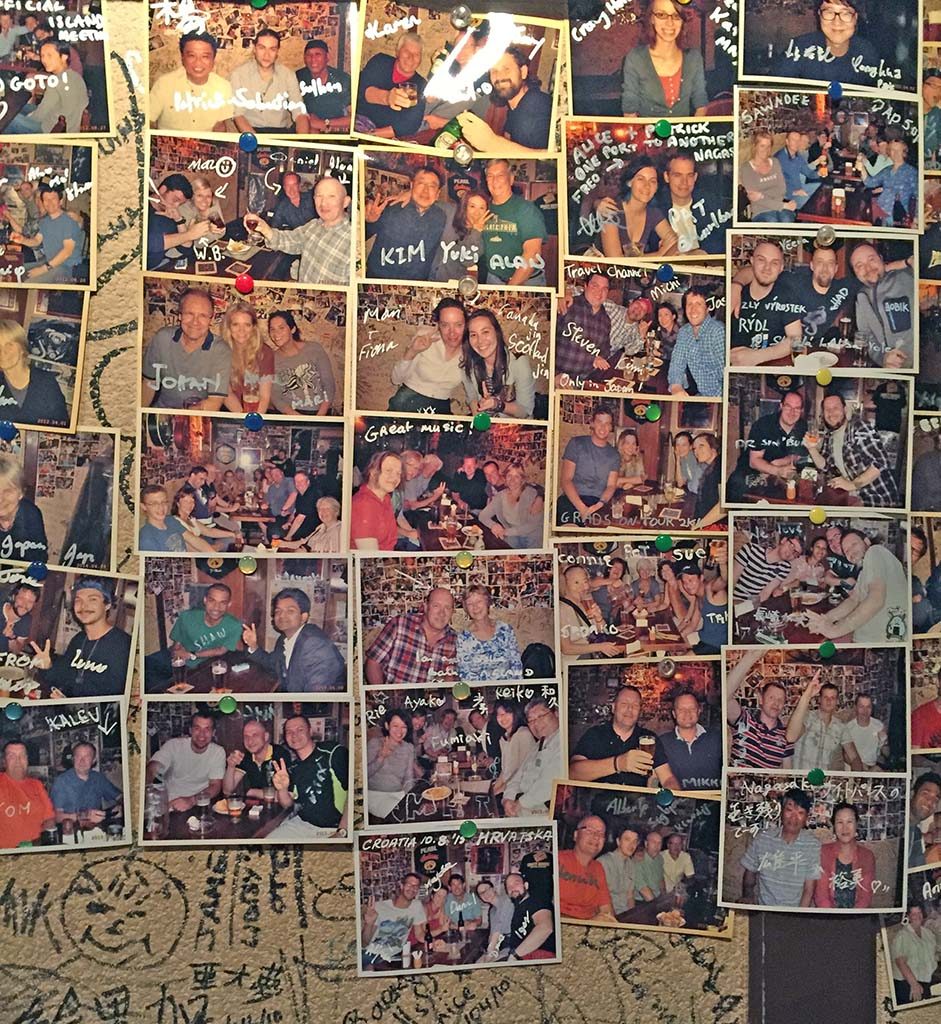
We did it gladly, and enjoyed a couple of drinks listening to something that we can call a “Beatles tribute band”. A band formed by four old Japanese musicians who don’t speak English. That means that they play instruments quite well, and it all sounds like real Beatles, except made up words. Something like a famous “Ken Lee”. (If you don’t know “Ken Lee”, Google it as soon as you finish reading this.) 🙂
After the funny night in Crazy Horse, we headed back to Majda’s and Carl’s apartment, as we had to catch the first “slow” train to Fukuoka the next morning.
Nagasaki, unlike other places we’ve been in Japan, even though it’s home to almost 0.5 million people looked somehow different, or to say – boring. From the talks we had with Daniel and others it seems that everything in Nagasaki exists for and because of Mitsubishi corporation, and there’s not much in it. We heard that young people from Nagasaki go out for parties, shopping and even move to live in near by Fukuoka, and that Nagasaki is slowly turning into a place for old people.
Still, it’s a very nice place with delicious food, and I hope I’ll have a chance to visit it again one day.
Even though it’s been more than a year ago now, I’d like to thank Majda and Carl for letting us crash in their living room, then to thank Majda and Aljosa for guiding us around the town and beautiful beaches, and a big thanks to Daniel who was patient enough to answer all my food and Japan related questions, translating all the menus, and taking us to the crazy bar. 🙂
Thanks guys!
Till the next one.
Kisses,
Balky

You must be logged in to post a comment.